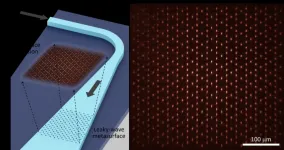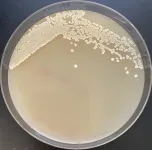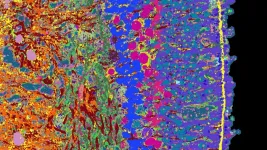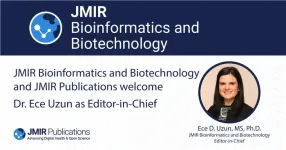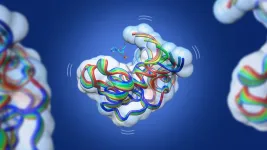(Press-News.org) CAMBRIDGE, MA -- Much of the human genome is made of regulatory regions that control which genes are expressed at a given time within a cell. Those regulatory elements can be located near a target gene or up to 2 million base pairs away from the target.
To enable those interactions, the genome loops itself in a 3D structure that brings distant regions close together. Using a new technique, MIT researchers have shown that they can map these interactions with 100 times higher resolution than has previously been possible.
“Using this method, we generate the highest-resolution maps of the 3D genome that have ever been generated, and what we see are a lot of interactions between enhancers and promoters that haven't been seen previously,” says Anders Sejr Hansen, the Underwood-Prescott Career Development Assistant Professor of Biological Engineering at MIT and the senior author of the study. “We are excited to be able to reveal a new layer of 3D structure with our high resolution.”
The researchers’ findings suggest that many genes interact with dozens of different regulatory elements, although further study is needed to determine which of those interactions are the most important to the regulation of a given gene.
“Researchers can now affordably study the interactions between genes and their regulators, opening a world of possibilities not just for us but also for dozens of labs that have already expressed interest in our method,” says Viraat Goel, an MIT graduate student and one of the lead authors of the paper. “We’re excited to bring the research community a tool that help them disentangle the mechanisms driving gene regulation.”
MIT postdoc Miles Huseyin is also a lead author of the paper, which appears today in Nature Genetics.
High-resolution mapping
Scientists estimate that more than half of the genome consists of regulatory elements that control genes, which make up only about 2 percent of the genome. Genome-wide association studies, which link genetic variants with specific diseases, have identified many variants that appear in these regulatory regions. Determining which genes these regulatory elements interact with could help researchers understand how those diseases arise and, potentially, how to treat them.
Discovering those interactions requires mapping which parts of the genome interact with each other when chromosomes are packed into the nucleus. Chromosomes are organized into structural units called nucleosomes — strands of DNA tightly wound around proteins — helping the chromosomes fit within the small confines of the nucleus.
Over a decade ago, a team that included researchers from MIT developed a method called Hi-C, which revealed that the genome is organized as a “fractal globule,” which allows the cell to tightly pack its DNA while avoiding knots. This architecture also allows the DNA to easily unfold and refold when needed.
To perform Hi-C, researchers use restriction enzymes to chop the genome into many small pieces and biochemically link pieces that are near each other in 3D space within the cell’s nucleus. They then determine the identities of the interacting pieces by amplifying and sequencing them.
While Hi-C reveals a great deal about the overall 3D organization of the genome, it has limited resolution to pick out specific interactions between genes and regulatory elements such as enhancers. Enhancers are short sequences of DNA that can help to activate the transcription of a gene by binding to the gene’s promoter — the site where transcription begins.
To achieve the resolution necessary to find these interactions, the MIT team built on a more recent technology called Micro-C, which was invented by researchers at the University of Massachusetts Medical School, led by Stanley Hsieh and Oliver Rando. Micro-C was first applied in budding yeast in 2015 and subsequently applied to mammalian cells in three papers in 2019 and 2020 by researchers including Hansen, Hsieh, Rando and others at University of California at Berkeley and at UMass Medical School.
Micro-C achieves higher resolution than Hi-C by using an enzyme known as micrococcal nuclease to chop up the genome. Hi-C’s restriction enzymes cut the genome only at specific DNA sequences that are randomly distributed, resulting in DNA fragments of varying and larger sizes. By contrast, micrococcal nuclease uniformly cuts the genome into nucleosome-sized fragments, each of which contains 150 to 200 DNA base pairs. This uniformity of small fragments grants Micro-C its superior resolution over Hi-C.
However, since Micro-C surveys the entire genome, this approach still doesn’t achieve high enough resolution to identify the types of interactions the researchers wanted to see. For example, if you want to look at how 100 different genome sites interact with each other, you need to sequence at least 100 multiplied by 100 times, or 10,000. The human genome is very large and contains around 22 million sites at nucleosome resolution. Therefore, Micro-C mapping of the entire human genome would require at least 22 million multiplied by 22 million sequencing reads, costing more than $1 billion.
To bring that cost down, the team devised a way to perform a more targeted sequencing of the genome’s interactions, allowing them to focus on segments of the genome that contain genes of interest. By focusing on regions spanning few million base pairs, the number of possible genomic sites decreases a thousandfold and the sequencing costs decrease a millionfold, down to about $1,000. The new method, called Region Capture Micro-C (RCMC), is therefore able to inexpensively generate maps 100 times richer in information than other published techniques for a fraction of the cost.
“Now we have a method for getting ultra-high-resolution 3D genome structure maps in a very affordable manner. Previously, it was so inaccessible financially because you would need millions, if not billions of dollars, to get high resolution,” Hansen says. “The one limitation is that you can't get the whole genome, so you need to know approximately what region you're interested in, but you can get very high resolution, very affordably.”
Many interactions
In this study, the researchers focused on five regions varying in size from hundreds of thousands to about 2 million base pairs, which they chose due to interesting features revealed by previous studies. Those include a well-characterized gene called Sox2, which plays a key role in tissue formation during embryonic development.
After capturing and sequencing the DNA segments of interest, the researchers found many enhancers that interact with Sox2, as well as interactions between nearby genes and enhancers that were previously unseen. In other regions, especially those full of genes and enhancers, some genes interacted with as many as 50 other DNA segments, and on average each interacting site contacted about 25 others.
“People have seen multiple interactions from one bit of DNA before, but it's usually on the order of two or three, so seeing this many of them was quite significant in terms of difference,” Huseyin says.
However, the researchers’ technique doesn’t reveal whether all of those interactions occur simultaneously or at different times, or which of those interactions are the most important.
The researchers also found that DNA appears to coil itself into nested “microcompartments” that facilitate these interactions, but they weren’t able to determine how microcompartments form. The researchers hope that further study into the underlying mechanisms could shed light on the fundamental question of how genes are regulated.
“Even though we're not currently aware of what may be causing these microcompartments, and we have all these open questions in front of us, we at least have a tool to really stringently ask those questions,” Goel says.
In addition to pursuing those questions, the MIT team also plans to work with researchers at Boston Children’s Hospital to apply this type of analysis to genomic regions that have been linked with blood disorders in genome-wide association studies. They are also collaborating with researchers at Harvard Medical School to study variants linked to metabolic disorders.
###
The research was funded by the Koch Institute Support (core) Grant from the National Cancer Institute, the National Institutes of Health, the National Science Foundation, a Solomon Buchsbaum Research Support Committee Award, the Koch Institute Frontier Research Fund, an NIH Fellowship and an EMBO Fellowship.
END
An unprecedented view of gene regulation
MIT engineers’ new technique analyzes the 3D organization of the genome at a resolution 100 times higher than before
2023-05-08
ELSE PRESS RELEASES FROM THIS DATE:
AI helps create better, simpler hepatitis, COVID-19 tests
2023-05-08
Going beyond pregnancy and COVID-19, the world could someday soon come to rely on at-home tests for many diseases thanks in part to AI-fueled improvements.
University of Florida scientists have used artificial intelligence tools to simplify a test that works for both hepatitis C and SARS-CoV-2, the virus that causes COVID-19. The simplified test happens in one small test tube in just a few minutes. With further refinement, it could come to doctor’s offices soon and, one day, even home tests that are as easy as a pregnancy test.
“We are trying to build a home-based test that is as reliable as a lab-based test,” said Piyush ...
Leaky-wave metasurfaces: A perfect interface between free-space and integrated optical systems
2023-05-08
New York, NY—May 8, 2023—Researchers at Columbia Engineering have developed a new class of integrated photonic devices--“leaky-wave metasurfaces”--that can convert light initially confined in an optical waveguide to an arbitrary optical pattern in free space. These devices are the first to demonstrate simultaneous control of all four optical degrees of freedom, namely, amplitude, phase, polarization ellipticity, and polarization orientation--a world record. Because the devices are so thin, transparent, and compatible with photonic integrated circuits ...
AI predicts future pancreatic cancer
2023-05-08
An artificial intelligence tool has successfully identified people at the highest risk for pancreatic cancer up to three years before diagnosis using solely the patients’ medical records, according to new research led by investigators at Harvard Medical School and the University of Copenhagen, in collaboration with VA Boston Healthcare System, Dana-Farber Cancer Institute, and the Harvard T.H. Chan School of Public Health.
The findings, published May 8 in Nature Medicine, suggest that AI-based population screening could be valuable in finding those at elevated risk for the disease and could expedite the diagnosis of a condition ...
Tiny microbes could brew big benefits for green biomanufacturing
2023-05-08
A research team led by Lawrence Berkeley National Laboratory (Berkeley Lab) and UC Berkeley has engineered bacteria to produce new-to-nature carbon products that could provide a powerful route to sustainable biochemicals.
The advance – which was recently announced in the journal Nature – uses bacteria to combine natural enzymatic reactions with a new-to-nature reaction called the “carbene transfer reaction.” This work could also one day help reduce industrial emissions because it offers sustainable ...
Human Brain Project: Study presents large brain-like neural networks for AI
2023-05-08
In a new study in Nature Machine Intelligence*, researchers Bojian Yin and Sander Bohté from the HBP partner Dutch National Research Institute for Mathematics and Computer Science (CWI) demonstrate a significant step towards artificial intelligence that can be used in local devices like smartphones and in VR-like applications, while protecting privacy. They show how brain-like neurons combined with novel learning methods enable training fast and energy-efficient spiking neural networks on a large scale. Potential applications range from wearable AI to speech recognition and Augmented Reality.
While modern artificial neural ...
Detailed image of the human retina
2023-05-08
What cell types are found in which human tissue, and where? Which genes are active in the individual cells, and which proteins are found there? Answers to these questions and more are to be provided by a specialised atlas – in particular how the different tissues form during embryonic development and what causes diseases. In creating this atlas, researchers aim to map not only tissue directly isolated from humans, but also structures called organoids. These are three-dimensional clumps of tissue that are cultivated in the laboratory and develop in a way similar ...
Welcoming Dr Ece Uzun, MS, PhD as the Editor-in-Chief for JMIR Bioinformatics and Biotechnology
2023-05-08
JMIR Bioinformatics and Biotechnology and JMIR Publications are thrilled to announce and welcome Dr Ece Uzun as Editor-in-Chief for JMIR Bioinformatics and Biotechnology.
Dr. Uzun is currently the Director of Clinical Bioinformatics and Associate Director of Clinical Cancer Informatics and Data Science (CCIDS) at Lifespan and an Assistant Professor of Pathology and Laboratory Medicine at Brown University Alpert Medical School. She has a B.S in Chemical Engineering and M.Sc in Biological Sciences and Bioengineering. She completed her PhD in Chemical Engineering at Northeastern University in 2010 and focused ...
Elucidating the mysteries of enzyme evolution at the macromolecular level
2023-05-08
Professor Nicolas Doucet and his team at Institut national de la recherche scientifique (INRS) made a major breakthrough earlier this year in the field of evolutionary conservation of molecular dynamics in enzymes. Their work, published in the journal Structure, points to potential applications in health, including the development of new drugs to treat serious diseases such as cancer or to counter antibiotic resistance.
As a researcher specializing in protein dynamics, Professor Doucet is captivated by things that are invisible to the naked eye, yet full of mysteries and essential to all forms of life. He studies proteins ...
Recent research advances on historical artifacts and their preservation
2023-05-08
Because we don’t have crystal balls to show us how the world used to look, scientists must rely on preserved artifacts and specimens to provide the details. Below are some recent papers published in ACS journals that have unearthed insights from historic items and provided suggestions for protecting relics. Reporters can request free access to these papers by emailing newsroom@acs.org.
“Two Pathways for the Degradation of Orpiment Pigment (As2S3) Found in Paintings”
Journal of the American Chemical Society
April 14, 2023
Oil paintings created before the 19th century often ...
Chinese Medical Journal review highlights the health hazards of air pollution
2023-05-08
Globally, air pollution is a major public health hazard. A key air pollutant linked to health risks is ambient fine particulate matter (PM2.5), which consists of minute particles, sized less than or equal to 2.5 μm, suspended in the air. According to the WHO, annual PM2.5 levels should not exceed 5 μg/m3. However, the current PM2.5 levels in China far exceed this standard and are responsible for approximately 1.4 million PM2.5-related excess deaths annually. Even as the country steadily works towards reducing ...
LAST 30 PRESS RELEASES:
Low daily alcohol intake linked to 50% heightened mouth cancer risk in India
American Meteorological Society announces Rick Spinrad as 2026 President-Elect
Biomass-based carbon capture spotlighted in newly released global climate webinar recording
Illuminating invisible nano pollutants: advanced bioimaging tracks the full journey of emerging nanoscale contaminants in living systems
How does age affect recovery from spinal cord injury?
Novel AI tool offers prognosis for patients with head and neck cancer
Fathers’ microplastic exposure tied to their children’s metabolic problems
Research validates laboratory model for studying high-grade serous ovarian cancer
SIR 2026 delivers transformative breakthroughs in minimally invasive medicine to improve patient care
Stem Cell Reports most downloaded papers of 2025 highlight the breadth and impact of stem cell research
Oxford-led study estimates NHS spends around 3% of its primary and secondary care budget on the health impacts of heat and cold in England
A researcher’s long quest leads to a smart composite breakthrough
Urban wild bees act as “microbial sensors” of city health.
New study finds where you live affects recovery after a hip fracture
Forecasting the impact of fully automated vehicle adoption on US road traffic injuries
Alcohol-related hospitalizations from 2016 to 2022
Semaglutide and hospitalizations in patients with obesity and established cardiovascular disease
Researchers ‘listen in’ to embryo-mother interactions during implantation using a culture system replicating the womb lining
How changing your diet could help save the world
How to make AI truly scalable and reliable for real-time traffic assignment?
Beyond fragmented markets: A new framework for efficient and stable ride-pooling
Can shape priors make road perception more reliable for autonomous driving?
AI tracks nearly 100 years of aging research, revealing key trends and gaps
Innovative techniques enable Italy’s first imaging of individual trapped atoms
KIER successfully develops Korea-made “calibration thermoelectric module” for measuring thermoelectric device performance
Diversifying US Midwest farming for stability and resilience
Emphasizing immigrants’ deservingness shifts attitudes
Japanese eels, climate change, and river temperature
Pusan National University researchers discover faster, smarter heat treatment for lightweight magnesium metals
China’s 2024 Gastroenterology Report: marked progress in endoscopy quality and disease management
[Press-News.org] An unprecedented view of gene regulationMIT engineers’ new technique analyzes the 3D organization of the genome at a resolution 100 times higher than before
